Monthly economic brief: August 2020
Provides a summary of latest key economic statistics, forecasts and analysis on the Scottish economy.
This document is part of a collection
Labour Market
The impacts of the coronavirus pandemic on Scotland's labour market are only starting to emerge with the Coronavirus Job Retention Scheme supporting jobs and incomes during lockdown.
Coronavirus Jobs Retention Scheme (CJRS) and Self Employment Income Support Scheme[12]
- The CJRS has been supporting job retention and incomes during the lockdown phase as businesses have been required to close or significantly scale down business operations.
- Up to the end of June 2020, 736,500 jobs had been furloughed in Scotland (9.4 million across the UK as a whole).This means that around 30% of employees in Scotland have been furloughed, in line with other parts of the UK (England: 30%; Wales: 29%; NI: 30%).
- Glasgow City (88,300) and Edinburgh City (69,500) were the local authorities in Scotland with the most claims, followed by North Lanarkshire (49,500).
- In terms of self-employed in Scotland, 155,000 (75% of eligible) self- employed individuals made a claim to the Self Employed Income Support Scheme (SEISS) up to the end of June.
- By local authority the highest take-up rate of the SEISS was in West Dunbartonshire (80%) and the lowest in Orkney Islands (60%).
- ONS data[13] show that the CJRS remained an important element of support for businesses in the second half of July. At a UK level, of businesses that had not permanently stopped trading, 14% of their workforce was estimated to be on furlough leave. This is down from 23% in the first half of June, and reflects the return of workers from furlough as business have reopened and resumed activity.
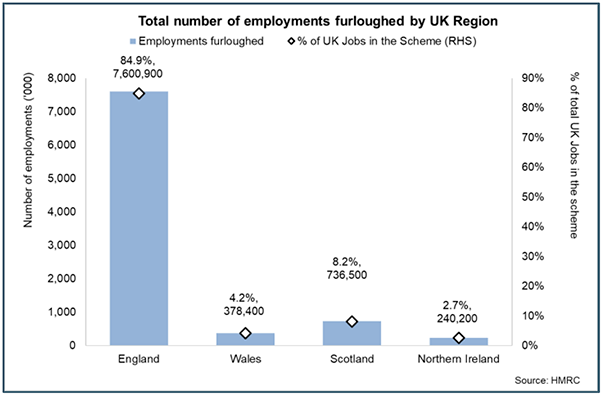
Figure Description
This chart shows the total number of employments furloughed by UK region and their percentage of total UK jobs furloughed. 8.2% of all UK jobs furloughed was in Scotland, 84.9% in England, 4.2% in Wales and 2.7% in Northern Ireland.
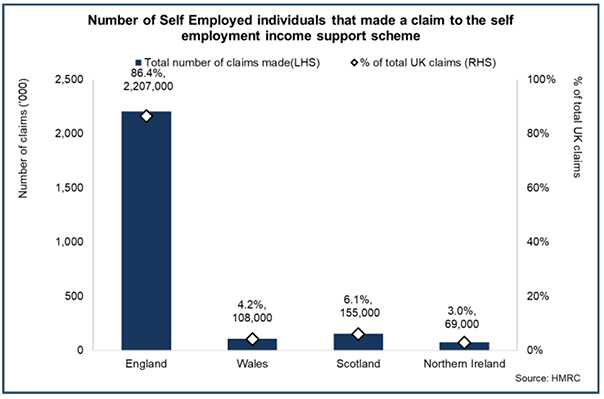
Figure Description
This chart shows the total number of Self Employed individuals that made a claim to the self-employment support scheme by UK region and their percentage of total UK claims. 6.1% of total UK claims was made in Scotland, 86.4% in England, 4.2% in Wales and 3.0% in Northern Ireland
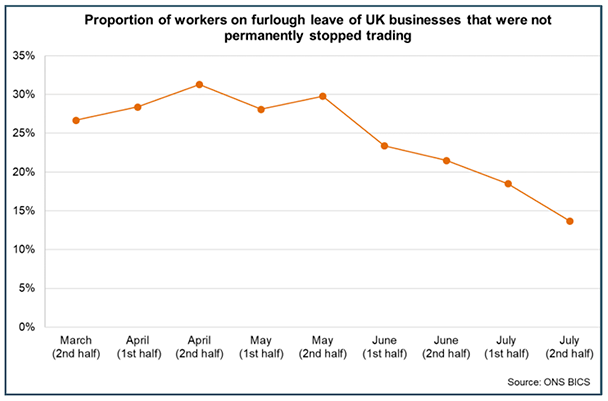
Figure Description
This chart displays a time series since the second half of March to the second half of July, of the percentage of workers on furlough leave of UK businesses that have not permanently stopped trading. The percentage of workers on furlough leave declined from its peak of 31% in the first half of April to 14% of the workforce in the second half of July.
Official labour market statistics
- The latest labour market statistics cover the period April to June when the economy was in full lockdown and in which businesses were receiving support through the Coronavirus Job Retention Scheme (CJRS) and the Self Employment Income Support Scheme (SEISS) to help retain and support employment levels.[14]
- Over the quarter to April to June 2020,[15] the employment level decreased by 15,000 in Scotland and the employment rate fell by 0.4 percentage points to 74.3% (UK: 76.4%).
- The fall in employment over the quarter is mainly reflected in a rise in the unemployment level by 11,000. The unemployment rate increased by 0.4 percentage points to 4.5% (UK: 3.9%).
- Economic inactivity (those neither in employment or ILO unemployed) also increased over the quarter, with the level rising by 3,000 and the inactivity rate increased by 0.1 percentage points to 22.2% (UK: 20.4%).
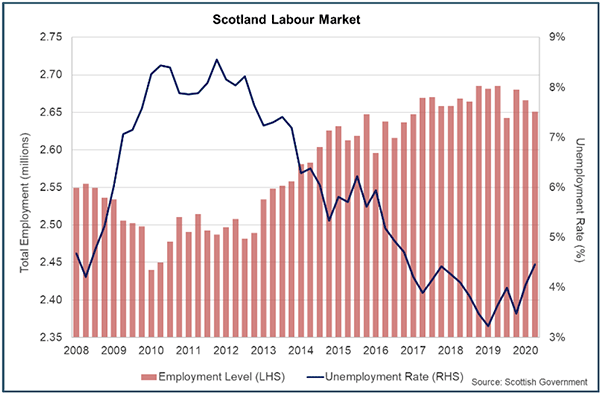
Figure Description
This chart shows the employment level in Scotland and the Scottish unemployment rate over time from 2008 up to June 2020. Over the quarter to April to June 2020, Scotland’s employment level declined by 15,000 employees to 2,651,000 employees and the unemployment rate increased by 0.4 percentage points to 4.5%.
The unwinding of COVID-19 labour market schemes and unemployment
The latest labour market statistics show that the rate of unemployment across April to June 2020 in Scotland was 4.5%. Although this has risen since the start of the year it suggests that the impact of Coronavirus on the labour market has yet to come through – some of the reasons for this are discussed by the Office for National Statistics (ONS).[16]
A key factor behind the relatively robust labour market data is the furlough and self-employment support schemes implemented by the UK government, which have supported around 900,000 jobs in Scotland since their introduction (736,500 employments on the CJRS and 155,000 claims on the SEISS). Furloughed workers are still considered to be employed in the labour market statistics, although they are temporarily unable to work. In our June Monthly Economic Brief, we set out analysis suggesting that unemployment could have risen to around 14% without these schemes.
The UK Government has announced the unwinding of these schemes and the eventual closure of the CJRS at the end of October. Consequently, it is likely that a number of jobs currently sustained by these schemes may be lost. The analysis below considers three different approaches to estimating the risk facing the labour market.
The first approach considers the historic relationship between the unemployment rate and monthly vacancy data; unemployment tends to be low when vacancies are high and vice versa. Vacancies have fallen to their lowest level since the series began and are lower than during the peak of the financial crisis. Subsequently, we estimate the unemployment rate that would historically be associated with these current levels of vacancies.
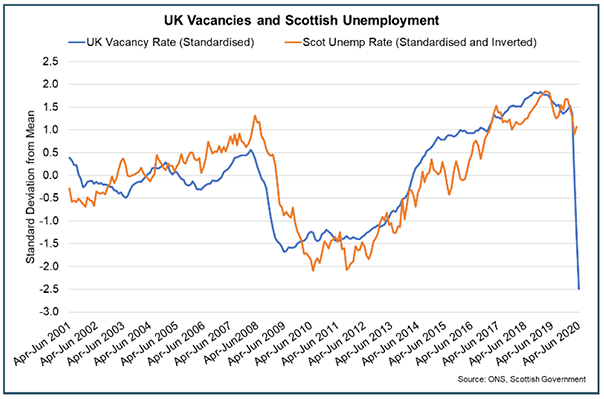
Figure Description
This charts demonstrates the historic relationship between the Scottish unemployment rate and UK vacancy data from 2001 to June 2020. The unemployment rate tends to be low when vacancies are high and vice versa. In April to June 2020, UK vacancies have fallen to their lowest level since the series began and are lower than during the peak of the financial crisis.
The second approach uses HMRC data on the number of jobs which have been supported in Scotland. In their latest central scenario, the Office for Budget Responsibility assumed 15% of furloughed jobs could be lost, whilst Resolution Foundation research suggested that between 10% and 24% of furloughed workers thought it likely that their jobs could be lost. Recently others such as the Bank of England and the National Institute of Economic and Social Research (NIESR) have also published further evidence or views on the likely share of furloughed workers whom may lose their jobs. Using this range of evidence, we use Monte Carlo analysis to translate these proportions into a range of estimates of the percentage of jobs that could be lost and what impact this would then have on the current unemployment rate. We take a high level approach and apply this to both the CJRS scheme and the SEISS claim numbers.
The third approach relies on previous modelling published by the Scottish Government in the June edition of the Monthly Economic Brief. This analysis uses the Scottish Government Global Econometric Model (SGGEM) – a large scale, global general equilibrium model to produce various scenarios on the medium term outlook of the Scottish economy, including that of the labour market.
The fan chart represents the range of results from the various approaches. This effectively represents an estimate of how many people in Scotland we think could potentially become unemployed, and how this compares to the current unemployment rate. From the approaches described above, we currently estimate that unemployment could increase to 6% to 10% as support is withdrawn, with more weight being placed on the central estimate in the region of 7% to 9%. A table of the methodologies and their results is shown below.
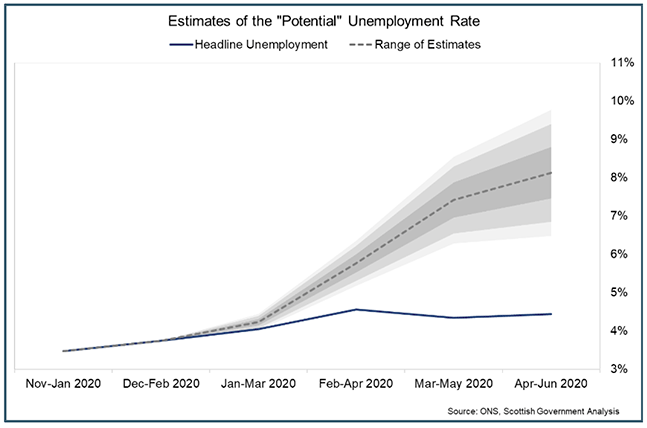
Figure Description
This fan chart represents the an estimate of how many people in Scotland we think could potentially become unemployed, and how this compares to the current unemployment rate in Scotland. We currently estimate that unemployment could increase to 6 percent to 10 percent as support is withdrawn, with more weight being placed on the central estimate in the region of 7 percent to 9 percent.
| Latest Results | Model Used | Description |
|---|---|---|
| Central Estimate: 8.0%; {95% Conditional probability of lying between 6.1 % and 10.0%} |
Monte Carlo Simulations (Methodology 1) |
Uses HMRC CJRS & SEISS data and evidence from a variety of internal and external sources |
| Central Estimate: 8.7%; {95% Confidence Interval lying between 8.5% & 8.9%} |
Statistical Regression (Methodology 2) |
Examines the historic relationship between monthly vacancy data and the unemployment rate |
| Range: 7.5% to 10% | General Equilibrium Model (Methodology 3) |
Scenario analysis on a range of possible COVID medium term outlooks |
Although there is still a high degree of uncertainty, it is noted that the estimates from three very different methodologies have created a range that are relatively aligned with one another. We know that the labour market interventions have been successful in preventing an immediate increase in unemployment, but there is a risk that they have simply deferred the increase in unemployment until later in the year when they are withdrawn.
These approaches estimate what may happen to unemployment solely as a result of the existing support schemes ending. There will be wider economic impacts, such as structural changes in the labour market due to a potential mismatch in skills between employers and employees, or people finding work through the new job creation schemes, which are not fully captured. However, based on the latest available data, we currently might expect the unemployment rate to rise to around 8% as the support schemes unwind, the same level as at the peak of the financial crisis.
Claimant Count
- Scotland's Claimant Count[17] (the number of claimants of Job Seekers Allowance and claimants of Universal Credit who were claiming principally for the reason of being unemployed) continued to rise in July reflecting that the number of people that are unemployed or employed with low income and/or low hours is increasing.
- In July, the number of claimants increased by 9,100 (4.3%) over the month to 222,300, taking the Claimant Count rate to 7.9% (UK: 7.5%).
- Compared to last year, the Claimant Count has more than doubled (up 102.4%), however most of that increase has come in recent months with the number of claimants rising by around 111,000 since March (+100%).
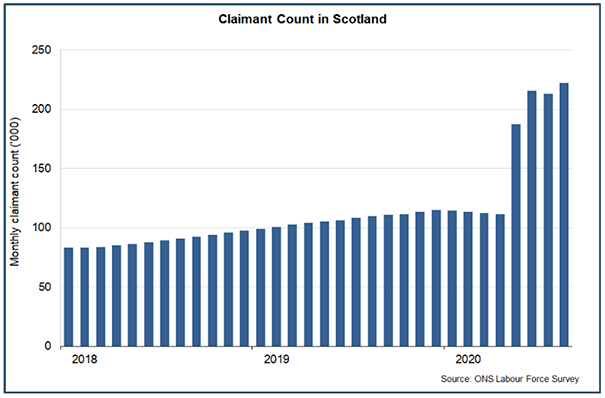
Figure Description
This chart shows the monthly claimant count numbers in Scotland from 2018 to July 2020. In April 2020, Scottish claimant count numbers increased sharply and the claimant count continued to be high in the months to July 2020. In July, the number of claimants was 222,300.
Hours worked
- Official labour market statistics for April to June 2020 record furloughed workers as employed, and as such, considering the number of people temporarily away from work and number of hours worked, provides further insights into labour market activity.
- Compared to the same time last year, the number of people in employment in Scotland who were temporarily away from paid work has more than tripled in April to June 2020 to 588,000 (up from 172,000). This accounts for 22.1% of people that are employed (6.4% in Apr-Jun 2019).
- The average weekly hours worked in Scotland for the period April to June 2020 have decreased significantly by 6.7 hours to 25.3 hours compared to same period in 2019, a decline of 21%.
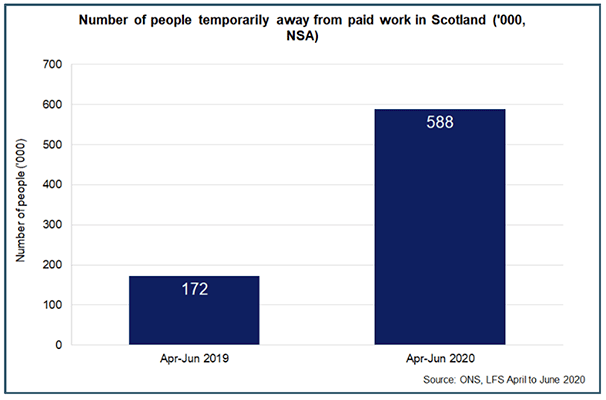
Figure Description
This chart compares the number of people temporarily away from paid work in Scotland in the period April to June 2020 to the same period one year ago.
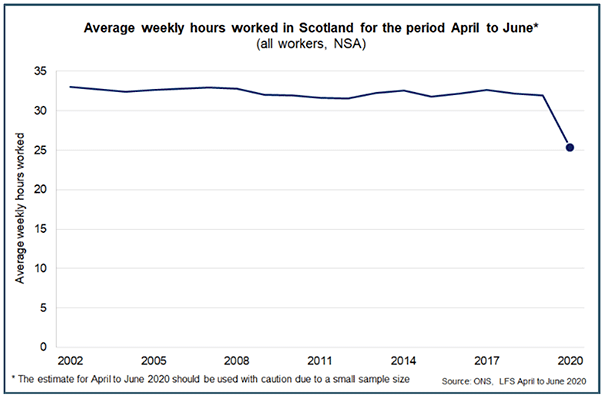
Figure Description
This chart displays the average weekly hours worked in Scotland for the period April to June of all workers since 2002. The average weekly hours worked lies between the 30 and 35 hours since 2002, however in 2020 the average weekly hours worked fell significantly to 25.3 hours on average.
Demand for staff in Scotland
- The RBS Report on Jobs survey for July[18] reported further falls in demand for permanent and temporary staff in Scotland, albeit to a lesser extent than in recent months.
- Staff placements and vacancies continued to fall over the month reflecting that businesses continued to freeze or delay hiring activity.
- Alongside this, candidate availability continued to rise in July for its second month suggesting a rise in redundancies, while pay pressures were evident with salaries appointed to new staff continuing to fall, though at their slowest rate since March.
- This is consistent with the PMI for July which reported that despite stabilisation in output, business continued to report falling staffing levels due to reduced production requirements.
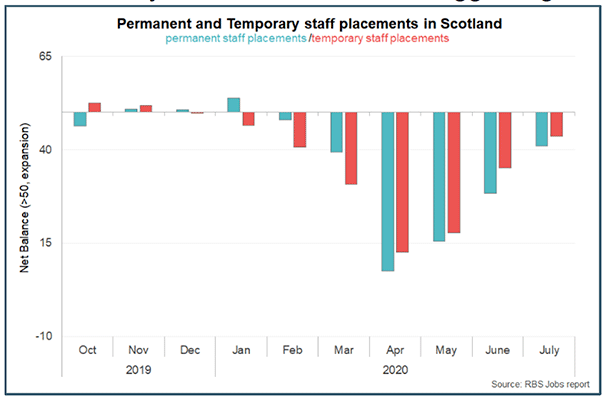
Figure Description
This chart shows the Net Balance scores of recruitment agencies on Permanent and Temporary staff placements in Scotland between October 2019 and July 2020.
Earnings
- The impact of the pandemic on business activity and Scotland's labour market has seen a sharp slowdown in earnings growth since March.
- PAYE[19] median monthly pay in Scotland in the three months to June was £1,838. This was an 0.2% increase from the same period last year having slowed from around 4% annual growth at the start of the year.
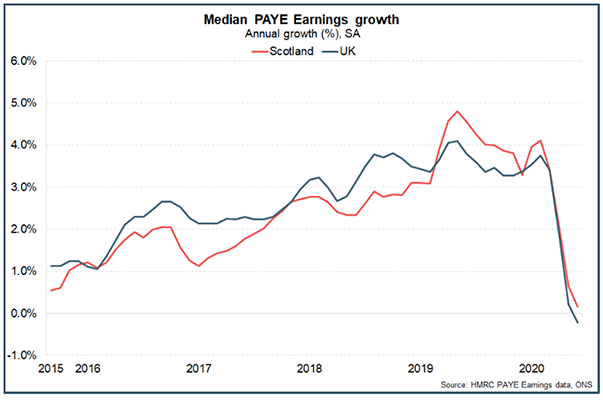
Figure Description
This chart shows a time series of the annual percentage growth in median ‘Pay As you Earn’ (PAYE) Earnings growth for the UK and Scotland from the end of 2015 to June 2020.
Contact
Email: OCEABusiness@gov.scot
There is a problem
Thanks for your feedback